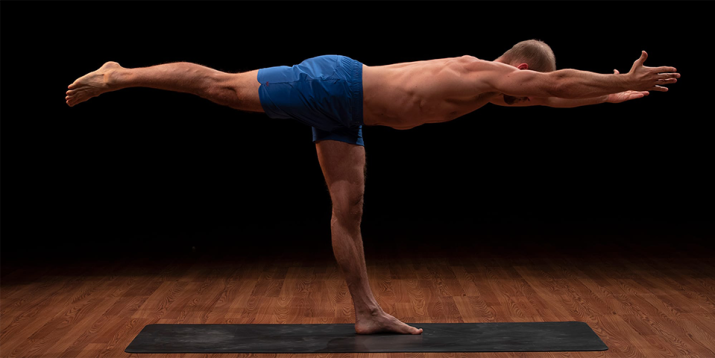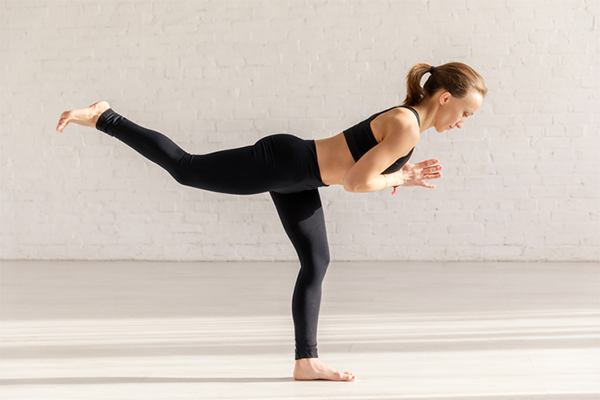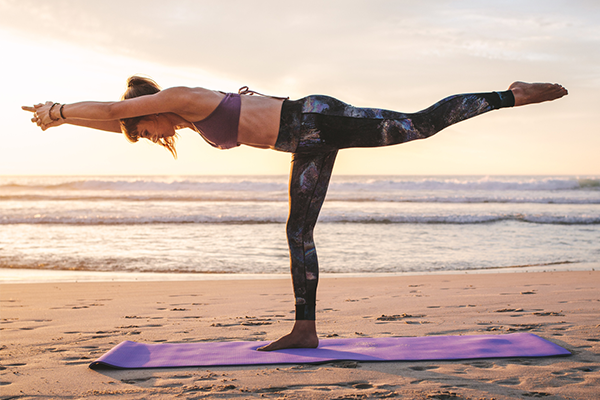How to Do Warrior 3 Pose in Yoga (Virabhadrasana III)

When it comes to multitasking, few yoga postures have as much to offer as warrior 3 pose (known in Sanskrit as virabhadrasana 3).
This standing balancing pose is challenging for beginners and advanced yogis alike, and it strengthens the body from head to toe.
Warrior 3 will reveal imbalances in your body (when one side feels weaker than the other), and it can also help even them.
“Balance is a skill that’s often low on the fitness priority list,” says Stephanie Saunders, Beachbody’s vice president of fitness programming. “However, unlike other areas of fitness that can be constrained by genetics, age, and mobility, balance can be improved. You may never get an Olympic gold medal in the 400-yard dash, but you can master warrior 3.”
If you’re willing to put in the work, warrior 3 pose will give you as much as it demands of you.
Here’s how to get started with virabhadrasana 3, one of many yoga warrior poses named for the fierce Hindu warrior Virabhadra.
How to Perform Warrior 3 Pose (Virabhadrasana 3)
Warrior 1 and warrior 2 poses can be used as entry points into warrior 3, as can mountain pose, high lunge, or half-moon pose, among others.
Here’s how to perform virabhadrasana 3 starting in mountain pose.
- Stand with your feet hips’ distance apart, with your hands at your sides or together in front of your heart. Engage your abs.
- Shift your weight onto your right foot, and lift your left knee, flexing your left foot.
- Shift your weight forward as you extend your left leg behind you, keeping your left foot flexed. Your upper body and back leg should be parallel with the mat.
- Hold your gaze toward the floor, keeping your head neutral.
- Adjust your hips so that your pelvis is parallel with the floor. Your right leg should be as straight as possible.
- Find your balance, and, if desired, bring your arms straight out in front of you, keeping your shoulders away from your ears.
- Hold the pose for five breaths, up to 30 seconds or longer. On an inhale, reverse the movement to return to mountain pose, and repeat on the other side.
How to Make Warrior 3 Pose Easier

Want the secret to making your warrior pose easier? Just keep doing it! Balance poses are supposed to be hard, but I remind my students that all the shaking and wobbling they feel are strength-in-progress. Here are some other tips to make warrior 3 pose easier.
- Use the wall. If you struggle to balance, press your hands into a wall. You can also press your back foot into a wall, which not only aids balance but also helps you learn to use your glutes.
- Keep your back leg bent. If you’re new to yoga or have tight muscles, warrior 3 can be modified. Instead of straightening your back leg and bringing your chest parallel with your mat, stay more upright until you feel strong and balanced.
- Change hand position. “Try keeping your hands in a prayer position at chest level or flying your arms back by your hips for balance,” says Saunders. “You can also extend your fingers to the floor or onto blocks for a more supported experience.”
How to Make Warrior 3 Pose Harder
The secret to making warrior 3 pose harder is simple: just keep doing it! Hold warrior 3 pose longer, perform more repetitions, or try one of these tips.
- Elevate your pose. “For more of a challenge, try standing on a yoga block while performing warrior 3,” suggests Saunders.
- Close your eyes. Balance becomes even more challenging when you take away your focal point.
- Pulse your back leg up and down an inch or so to work your glutes and lower body more.
- Flow in and out of warrior 3 pose instead of holding it. Come up on an inhale, and exhale into the pose.
Beginner’s Tips for Doing Warrior 3 Pose

Virabhadrasana 3, like all yoga warrior poses, takes time and practice.
“This is an asymmetrical balance pose, on one leg, that requires stabilization and proprioception,” says Saunders. “In other words, there’s a lot going on here. Take it slowly, and really focus on your hips remaining square with the floor, and know that this one never really gets easy.”
Be patient, and keep these tips in mind.
- Keep breathing. While balancing might feel easier if you hold your breath, that’s not yoga. Keep your mind and body steady through the pose by breathing deeply.
- Resist the urge to lift or drop your hip. Keep both hipbones level and pointing down.
- Stay flexed. Flexing your back foot keeps that leg activated and working, so that your lower back isn’t strained. This is what helps strengthen your glutes and hamstrings.
- If you extend your arms, make sure to keep your deltoids engaged by pressing your shoulder blades down your back. This prevents the weight of your arms from straining your shoulders while also building strength in those muscles.
- Don’t forget your standing leg. Try to keep it straight, but avoid locking your knee. If your hamstrings are tight, you can bend your knee to avoid pulling at your glutes.
- Each time you inhale in warrior 3 pose, find length and extension. Reach your arms forward and push your back heel backward. As you exhale, press into your standing leg.
Benefits of Warrior 3 Pose
Above all, warrior 3 is a balancing pose. Here are some of its other advantages.
1. Increases balance
Standing on one leg will definitely help with stability, which is so important to staying healthy and strong as you age.
2. Strengthens glutes and hamstrings
The lifted leg gets quite a glute and hamstring workout in virabhadrasana 3.
3. Strengthens your back and shoulders
While the back leg and arms are doing much of the work, your spine and shoulder muscles also get a workout in warrior 3 pose.
4. Strengthens your core
Keeping your deep abdominals engaged throughout virabhadrasana 3 secures your lower back and reinforces your core overall.
5. Strengthens legs
Your standing leg supports the weight of your entire body, which strengthens the muscles supporting your ankles, knees, and hips.
6. Helps with focus and concentration
Breathing while balancing on one foot isn’t easy! Warrior 3 pose helps you find stillness and helps hone your attention.
